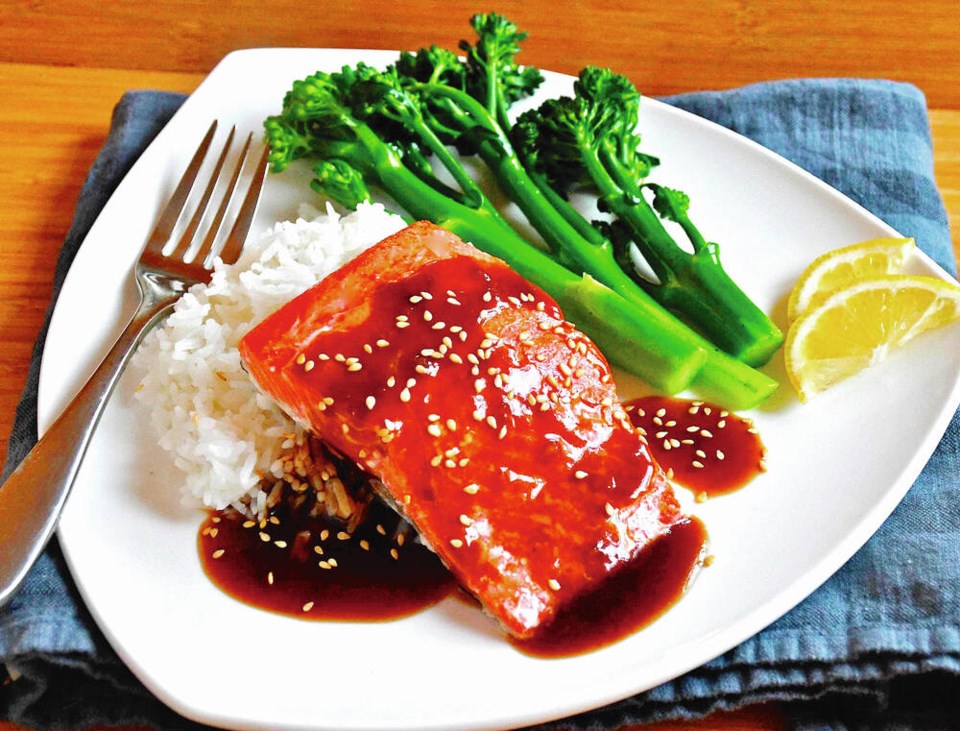If you struggle when cooking fish, keep things simple by setting some fish fillets in a pan, seasoning them, and baking them until cooked. No flipping required, as you’d have to do when searing or grilling fish.
Now, I can hear some of you saying I can never tell when fish is cooked. So, to remind you, the old fisherman’s rule of thumb is to allow 10 minutes of cooking time per inch (two and half centimetres) of thickness. To accurately gauge the thickness, measure the fish at its thickest point when lying flat on a work surface.
As noted in previous columns, this method seems to work pretty well, but your heating technique, what you cook the fish on or in, and the temperature do affect cooking time.
For example, when baking a fish fillet in the oven, the baking pan you set it in will have to heat through before the fish starts cooking on the bottom. This is why, in my recipe, a one-inch thick piece of salmon fillet took about 12 minutes to cook.
Salmon fillets vary in thickness, though, so when determining whether or not they or another type of fish fillet is cooked, remember that when it is, the fish will feel slightly firm and begin to flake slightly. If it’s too soft it’s not cooked through. And if it’s very firm and really beginning to flake, it’s overcooked. With regard to salmon, when cooked, a white protein may also seep out from the flakes of the fish.
In my recipe, after baking and plating the salmon, I dressed it up Asian-style by topping it with a soy-, citrus- and ginger-flavoured glaze, with a flavour profile similar to Japanese ponzu sauce. Other fish fillets will also work in the recipe (see Eric’s options of details).
You can serve the fish with rice and a steamed green vegetable, such as broccolette, also called broccolini, gai lan or baby bok choy.
Baked Salmon with Soy Citrus Ginger Glaze
Simple seasoned salmon fillets, baked, plated and topped with a beguiling glaze, flavoured with such things as soy sauce, citrus juice and fresh ginger.
Preparation time: 20 minutes
Cooking time: 12 minutes
Makes: two servings
2 (about 1-inch thick, 5- to 6-ounce/140- to 170-gram) salmon fillets (see Eric’s options)
2 tsp vegetable oil (divided)
• salt and ground white pepper, to taste
2 Tbsp soy sauce ( I used Kikkoman brand)
1 Tbsp + 1 tsp orange juice
1 Tbsp lemon juice
1 Tbsp water
2 tsp honey
1/2 tsp finely grated fresh ginger, or 1/8 tsp ground ginger
1/2 tsp sesame oil
1/2 tsp cornstarch
• roasted sesame seeds, to taste (optional; see Note)
Preheat oven to 400 F. Line a baking pan with parchment paper. Set on the salmon, skin-side down. Brush the top of each piece of salmon with 1 tsp oil; season with salt and pepper. Bake salmon 12 minutes, or until cooked through.
While salmon cooks, make glaze by combining soy sauce, juices, water, honey, ginger, sesame oil and cornstarch in a small pot. Bring to a simmer over medium-high heat, simmer 20 seconds, and then remove from the heat and cover.
When salmon is cooked, set a piece of the fish on each of two dinner plates. Spoon some glaze over each piece of fish, sprinkle with roasted sesame seeds, if using, and serve.
Note: Roasted sesame seeds are sold in the Asian-foods aisle of many grocery stores. If you want to toast your own sesame seeds, place a single layer of regular sesame seeds in a non-stick skillet set over medium heat. Cook the seeds, swirling the pan from time to time, until lightly toasted, about three to four minutes.
Eric’s options: Instead of salmon, try another type of similar sized fish fillet in this recipe, such as halibut or cod.
Eric Akis is the author of eight cookbooks. His columns appear in the Life section Wednesday and Sunday.



